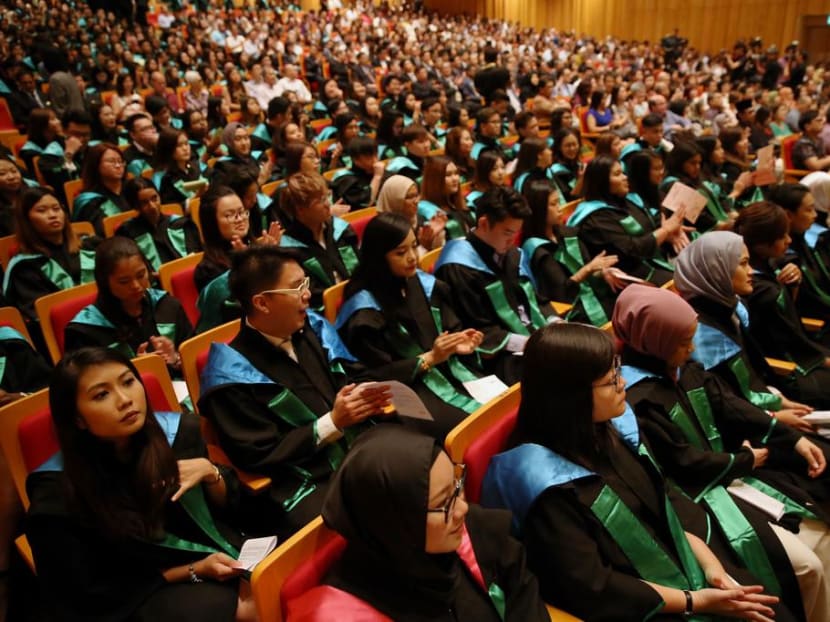Lower fees at SIT, SUSS and higher varsity, polytechnic grants from next academic year
SINGAPORE — After a review of tertiary education fees and grants, the authorities will cut annual charges for full-time general degrees at the Singapore Institute of Technology (SIT) and Singapore University of Social Sciences (SUSS), Prime Minister Lee Hsien Loong announced on Sunday (Aug 18).

Students in polytechnics and universities can expect to pay lower fees with higher bursaries and grants, Prime Minister Lee Hsien Loong said at the National Day Rally.
SINGAPORE — After a review of tertiary education fees and grants, the authorities will cut annual charges for full-time general degrees at the Singapore Institute of Technology (SIT) and Singapore University of Social Sciences (SUSS), Prime Minister Lee Hsien Loong announced on Sunday (Aug 18).
The fees will drop from about S$8,000 to S$7,500 a year, Mr Lee said during his National Day Rally speech at the Institute of Technical Education (ITE) College Central.
University students can also look forward to higher government bursaries for all government-funded undergraduate courses. For example, the bursaries will cover up to 75 per cent of the fees of general degrees, up from a maximum of 50 per cent today, Mr Lee said.
Bursaries for polytechnic diploma courses will also be increased, covering up to 95 per cent of fees. Today, these cover up to 80 per cent.
Students in government-funded diploma and degree courses at ITE, the Nanyang Academy of Fine Arts and Lasalle College of the Arts will also be covered.
Mr Lee said six in 10 students in polytechnics and universities are eligible for these grants. “So, these enhancements will benefit many middle-income students, too,” he said.
The Government will also strengthen government bursaries for medical studies, in an effort to attract students from diverse backgrounds. Including varsity grants, lower-income students will pay S$5,000 a year at most, instead of tens of thousands.
All these changes will benefit existing and new students from the next academic year.
Here are the moves at a glance:
LOWER FEES AT TWO UNIVERSITIES
SIT and SUSS, two of six public universities here, are “more applied, and do more industry attachments and internships”, Mr Lee noted.
Their operating costs for every student can therefore be lower, especially as intakes increase.
The annual fees for their full-time general degrees will thus be cut.
HIGHER BURSARIES: UNIVERSITY DEGREES
How will the higher government grants for general university degrees translate into savings?
-
For example, students in general degree courses such as economics or computer science at the National University of Singapore (NUS) shell out about S$8,000 in fees a year.
-
At present, lower-income students pay about half — S$4,000 a year — if they use their bursaries fully on fees.
-
With the enhanced grants, they will pay S$2,000 a year.
HIGHER BURSARIES: POLYTECHNIC COURSES
What about polytechnic students?
-
Polytechnic students pay about S$3,000 in fees a year.
-
Right now, lower-income students fork out about S$600 a year.
-
With the enhanced grants, they will pay S$150 a year.
MAKING MEDICAL STUDIES MORE AFFORDABLE
Turning to the study of medicine, Mr Lee said that making it more affordable is to encourage lower-income students to take it up.
For now, after government subsidies, medical studies come up to almost S$29,000 a year at NUS and S$35,000 at Nanyang Technological University — the highest among all university courses.
“We should not let the cost of medical school deter good students from studying medicine,” the prime minister said. “We want doctors to have diverse educational and family backgrounds.”
Mr Lee noted that more polytechnic graduates were gaining admission to medical school and NUS recently took in a graduate from ITE for the first time.
“If you add… the government bursary for medicine plus other bursaries from the university, then lower-income students will now pay at most S$5,000 per year to study medicine,” Mr Lee said.
He added that this balance could be covered with much less difficulty by student loans.

The changes, Mr Lee stressed, are not merely about the “dollars and cents”.
They are part of efforts to make Singapore’s education system as accessible as possible.
“We want every Singaporean son and daughter to have the opportunity to receive a good education, and start well in life, regardless of family circumstances”.
Students from lower-income families, he said, should not feel disadvantaged or inferior to their more well-to-do classmates, or be deterred from pursuing a course for financial reasons.
“This is fundamental to maintaining Singapore as an open meritocracy,” he added.
CALL ON VARSITIES TO SET UP MORE BURSARIES
In his speech, Mr Lee also urged universities, polytechnics and the ITE to set up more bursaries named after people.
Such existing bursaries include the Kwa Geok Choo Bursary established by the NUS law faculty to help students who are financially disadvantaged. It is named after the late Madam Kwa, who died in 2010. She was Mr Lee’s mother and the wife of founding statesman Lee Kuan Yew.
Prime Minister Lee said that the “warm personal feeling” stirred by such bursaries is not so easily kindled by government bursaries.
He also called on the alumni and community to donate generously to these school bursaries, saying that the Government will match contributions, up to three times for newer universities and up to 1.5 times for the rest.
“Bursaries can make a crucial difference to the recipients — and they have the extra human touch.
“If you donate towards a bursary, you enable some promising young person to get a good start in life,” Mr Lee said.











